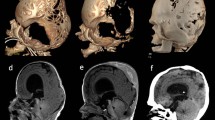Abstract
Introduction
We present our treatment concept for cloverleaf skull deformity on the basis of two representative cases that had been presented to our multidisciplinary skull deformity board.
Methods
Perioperatively, we monitored electrophysiologic parameters with median nerve somatosensory-evoked potentials (SSEP), tibial nerve (T) SSEP, brainstem acoustic-evoked potential and flush-elicited visual-evoked potential, as well as intracranial pressure. Both patients underwent decompressive bilateral vault craniectomy, frontal and occipital reshaping at an age of four months.
Results
Secondary fronto-orbital advancement and cranial vault reshaping was performed after maximal vault reossification was reached at an age of 8 and 12 months, respectively. Additionally, one of the patients underwent treatment of a Chiari malformation via suboccipital decompressive craniectomy and tonsillary resection, as well as ventriculoperitoneal shunting for hydrocephalus.
Discussion
The patients showed nearly unrestrained neural and neurophysiological development over a follow-up period of 5 years.
















Similar content being viewed by others
References
Apert E (1906) De l’acrocephalosyndactalie. Bull Soc Med Hop Paris 23:1310
Brivio E, Grasso R, Salvaggio A, Principi N (1993) Brain-stem auditory evoked potentials (BAEPs): maturation of interpeak latency I-V (IPL I-V) in the first years of life. Electroencephalogr Clin Neurophysiol 88:28–31
Cohen MM (1988) Craniosynostosis update 1987. Am J Med Genet Suppl 4:99–148
Desmedt JE, Brunko E, Debecker J (1976) Maturation of the somatosensory evoked potentials in normal infants and children, with special reference to the early N1 component. Electroencephalogr Clin Neurophysiol 40:43–58
Kaiser AM, Whitelaw AG (1986) Normal cerebrospinal fluid pressure in the newborn. Neuropediatrics 17(2):100–102
Lodge ML, Moore MH, Trott HA, JA DDJ (1993) The cloverleaf skull anomaly: managing extreme cranio-orbitofaciostenosis. Plast Reconstr Surg 91(1):1–9, discussion 10-4
Norman MG, McGillvray BC, Kalousek DK, Hill A, Poskitt KJ (1995) Congenital malformations of the brain. Oxford University Press, New York, pp 365–368
Renier D, Lajeunie E, Arnaud E, Marchac D (2000) Management of craniosynostosis. Childs Nerv Syst 16:645–658
Rothagi M (1991) Cloverleaf skull—a severe form of Crouzon’s syndrome: a new concept in aetiology. Acta Neurochir (Wien) 108:45–52
Steinberger D, Mueller U, Junger TH, Howaldt HP, Christophis P (1999) Mutation of FGFR2 (cys278phe) in craniolacunia and pansynostosis. JMedGenet 36(6):499–500
Stoehr M (ed) (2005) Evozierte Potentiale. Springer Verlag, Heidelberg, pp 21–433
Author information
Authors and Affiliations
Corresponding author
Rights and permissions
About this article
Cite this article
Preuss, M., Stein, M., Neubauer, B.A. et al. About the operative management and post-operative neural development of patients with cloverleaf skull deformity. Childs Nerv Syst 26, 1211–1218 (2010). https://doi.org/10.1007/s00381-010-1114-1
Received:
Accepted:
Published:
Issue Date:
DOI: https://doi.org/10.1007/s00381-010-1114-1




